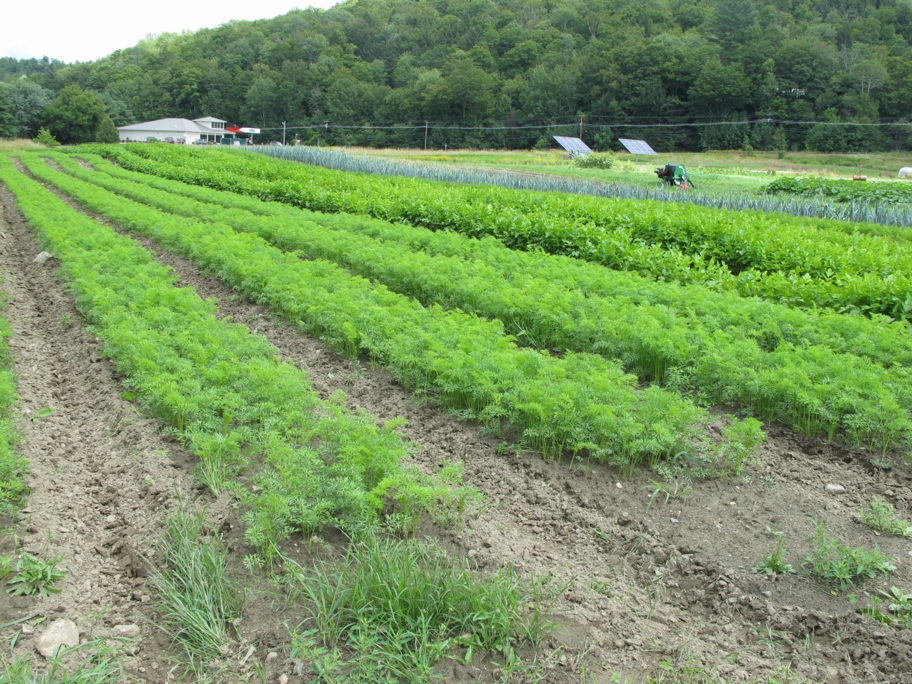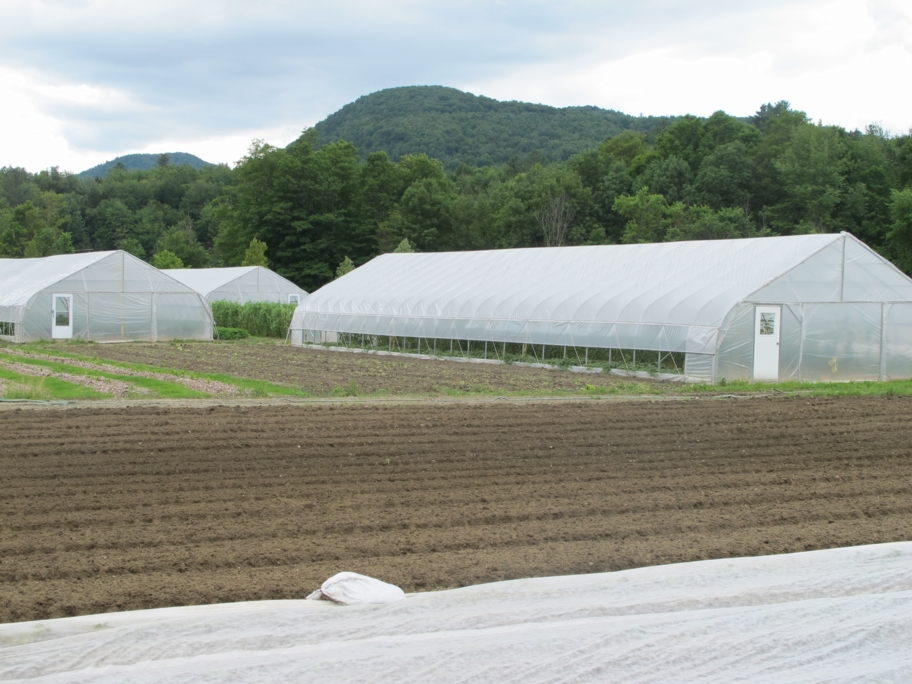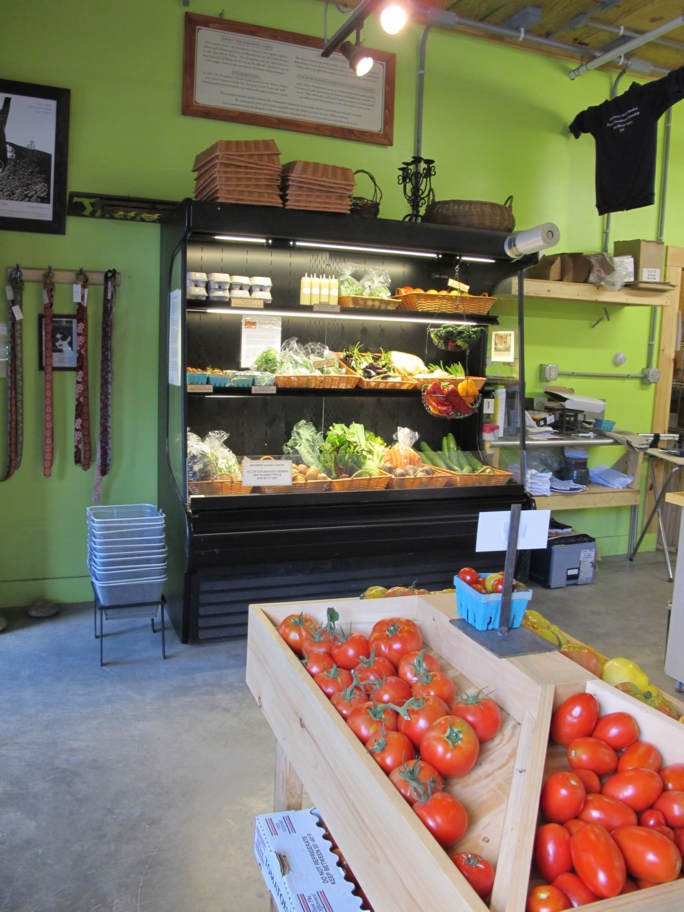Always good to read about the growth of ag participation. Beyond the access to food, one big impact to the increase of farmers and farmers markets is a more involved and better connected community. We are working on the NH side of the border to restore not only our agricultural businesses, but also the community which thrives in the locavore movement.
Blog Post
Local Food and Resilience

In this final installment of my ten-part series on resilient design, I'm taking a look at where our food comes from and how we can achieve more resilient food systems.
The average salad in the U.S. is transported roughly 1,400 miles from farm to table, and here in the Northeast, we get most of our fresh food from more than 3,000 miles away. Even in Iowa, where 95% of the land area is in agricultural production, one is hard-pressed to buy locally grown produce.
If some sort of crisis causes a shortage of diesel fuel, grocery shelves will be depleted in a matter of days. And if severe, extended drought occurs in the West combined with a lack of winter snowpack in the Rockies, the Colorado River--upon which much of California's most productive farmland is dependent--might not deliver enough water, causing food shortages and skyrocketing prices. A resilient food system will require that a far higher percentage of our food be produced more locally. Here in Vermont, only 5% of the food we eat is currently grown within the state, according to Vermont's Farm to Plate Strategic Plan, released in July 2011.
But there is reason for optimism:
In many parts of the country, the number of farms is growing for the first time in a generation--even as the total land area in agriculture continues to drop. And many of these newer farms are engaged in direct sales of food to consumers. In Vermont, 21% of farms are engaged in direct sales of produce to consumers, according to UVM Agricultural Extension Vegetable and Berry Specialist Vern Grubinger. Remarkably, Vermont leads the nation in direct sales of agricultural produce to consumers, with an average of $36.77 spent annually per capita in the state (2007) at farm stands, farmers' markets, and "community supported agriculture" (CSA) operations.

Nationwide, in August 2011, there were nearly 7,200 farmers' markets, up from just 4,100 in 2005. In Vermont, the number of farmers' markets grew from 19 in 1986 to 87 in 2010, Grubinger reported at the Northeast Organic Farming Association of Vermont (NOFA) annual meeting in Burlington this past weekend.
SUPPORT INDEPENDENT SUSTAINABILITY REPORTING
BuildingGreen relies on our premium members, not on advertisers. Help make our work possible.
See membership options »With CSAs, consumers buy shares of a farm's output, and they usually pay for that up-front, providing farmers with needed capital to get crops into the ground. From 1986 to 2010, the number of CSAs in Vermont increased from 2 to 81, according to Grubinger. Local farm stands, food co-ops, and local-food sections of grocery stores also support local farming--while providing customers with higher-quality, healthier food.
Food production can be even more local than nearby farms. We learned during World War II that Americans have the capacity to grow a significant fraction of their vegetables at home. As much as 40% of fresh produce consumed by Americans during the War was produced in homeowners' victory gardens, allowing more of the nation's farm output to be sent overseas to soldiers. While we have more than twice the population today, and thus less land per person, there is still significant potential for home gardens.
Local food production can be supported through our buying decisions, but also through our policies. Strong local protection of open, arable land is key to enabling food resilience to emerge. Zoning that restricts development of farmland is an important--though often contentious--step in this direction. Also important is the allowance of farm-related activities in and around our towns and cities. Many places still prohibit raising chickens and other farm animals, though these restrictions are easing. Even in such urban areas as New York City and Chicago, keeping a small flock for egg production is now permitted, though roosters are typically prohibited. More extensive urban farms are popping up from Philadelphia to Seattle.

In Vermont, we don't know exactly how much of our food comes from within the state, since nobody tracks food imports and exports at the state level. But Westminster, Vermont resident Dave Timmons, who is on the economics faculty at UMass Boston as well as an instructor in Marlboro College's MBA program, Managing for Sustainability, has done a lot of thinking and writing on this topic. By comparing Vermont's production and consumption with national levels, the largest the Vermont portion of our diet could be at the moment is about 38%, he says. That could be achieved if every calorie that was both produced and needed in the state stayed here (though this is clearly not the case; for example, Vermont both exports and imports apples).
By re-allocating land uses and shifting some agricultural production away from dairy towards grains, for example (because the state currently produces more dairy than its residents consume), it is relatively easy to see how Vermont could become nearly self-sufficient in food (though without such crops as bananas, avocados, pecans, and oranges that can't be grown here). Bill McKibben, in his book Deep Economy, suggested that Vermont could become food self-sufficient within one year if needed.
A far more resilient food system is achievable in Vermont--and most states--if we make local food and, especially, direct sales of farm produce to consumers, a priority. Doing so would take some changes in our land-use patterns and priorities, but it is comforting to know that, fundamentally, we could create a fully resilient food system here.
About this series
Throughout this resilient design series, I have covered how our homes and communities can continue to function in the event of extended power outages, interruptions in heating fuel, or shortages of water. Resilient design is a life-safety issue that is critical for the security and wellbeing of families in a future of climate uncertainty.
Alex is founder of BuildingGreen, Inc. and executive editor of Environmental Building News. To keep up with his latest articles and musings, you can sign up for his Twitter feed.
Published February 14, 2012 Permalink Citation
(2012, February 14). Local Food and Resilience. Retrieved from https://www.buildinggreen.com/blog/local-food-and-resilience
Comments
Just a thought on the compari
Just a thought on the comparison to WW2 "victory gardens": You note that the US population has doubled since WW2, which diminishes overall land per person. However, recall that at that time, there was a much greater dichotomy of people living either in rural areas or in dense cities. Now, a huge proportion of the population lives in suburbs. I don't know how the numbers shake out exactly, but the possibility is real that access to land for purposes of gardening has increased, not necessarily in terms of the fraction of the population with such access (though that is a technical possibility) but in terms of the number of "plots" of land within easy reach of a potential gardener. As an exaggerated example, whereas in WW2 you might have had a bunch of farmer's wives tending one-acre gardens along with numerous city dwellers with little garden access, now you have masses of families with quarter-acre yards at hand as well as those city dwellers.
It's ironic that you chose to
It's ironic that you chose to highlight the Kingsbury Farm (which is actually in Warren). While bringing that hayfield back into vegetable production certainly added to the agricultural capacity of the Mad River Valley, the process by which it occurred fractured the local community – and community solidarity is also an essential part of resilience.
I was on the committee that gathered community input for the best use of the old Kingsbury farmstead and participated in buyer selection. We were all delighted when the Vermont Food Bank put in a last minute proposal for purchase, which included a major investment in renovation, keeping the land open to other community uses, and a promise of non-competition with established local organic farmers. The intent was to grow produce for the Food Bank to distribute to local and regional food pantries to improve nutrition for food-challenged families.
But a change in CEO at the Food Bank resulted in a withdrawal of operating capital which necessitated a partnership with a for-profit farmer. The lease fee is paid to the Food Bank in tonnage of produce, which does go to needy families. The rest of production, including the new commercial bakery in a property that was pre-empted from town control because it was deemed primarily agricultural by the state, is profit to the farm couple and competes with established farms, in no small part because of its high exposure on a heavily-traveled tourist route.
There is no question that Vermont needs more local organic production and the market is hardly saturated, but the contentiousness around this project was because this property was subsidized by the community to bring the $495,000 market price down to $225,000, and benefited from an additional $200,000+ investment from the non-profit Food Bank in renovations and mechanical systems upgrades as well as farm machinery and a large walk-in cooler.
While the farm couple has created a meticulous landscape and an efficient production capacity, it was designed to operate with as little human labor as possible, using machinery wherever it could replace farmhands, which did little to improve the depressed job market. And the farmers, though dismissive of non-profit involvement in agriculture, have benefited from a significant community investment that was unavailable to other farmers. So it's not clear that this "success story" is a valid model for the future of farming in Vermont or for building community-based resilience.
Thanks for addressing this to
Thanks for addressing this topic and shedding light on Vermont's potential for becoming food self-sufficient. It's good to see local food production and self-sufficiency gaining ground across the nation.



Add new comment
To post a comment, you need to register for a BuildingGreen Basic membership (free) or login to your existing profile.